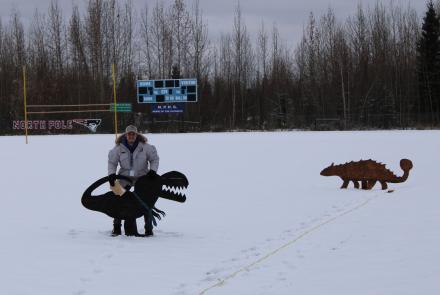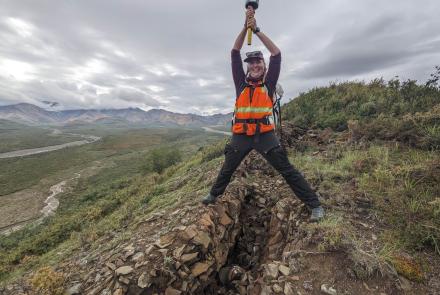Salcha quake provided a rapid-response opportunity for UAF grad students
Alex Fozkos was shopping. Sebin John was working on his computer at home.
The day quickly became action-packed for both University of Alaska Fairbanks seismology graduate students at 12:34 p.m. that Friday, Jan. 19.
A magnitude 5.3 earthquake occurred at that moment just 30 miles from the UAF campus. It was the largest quake in the region in more than 20 years.
“I was at the Fred Meyer west in the pots and pans aisle when the earthquake hit,” Fozkos said. “It was kind of movie-esque, seeing all the pots and pans start shaking. And then I realized it was an earthquake and that I needed to finish shopping so I could come here to the Alaska Earthquake Center and start working.”
John, working at home, knew the quake was a large one and that he needed to head to the Earthquake Center, located at the UAF Geophysical Institute.
“Once I got to the Alaska Earthquake Center, it was a little hectic,” he said. “Meetings were happening pretty fast, and there was a lot of energy.”
Both graduate students contributed to the rapidly developing earthquake analysis.
John created an intensity map using data to quantify the amount of shaking. Data from numerous seismometers in Alaska and models from previous earthquakes are combined to map out the shaking that occurred across the region.
Fozkos helped create a map showing previous earthquakes in the Salcha Seismic Zone back to 1988. Seismologists can use that data to infer the existence of a large fault that can't be seen by looking at the surface.
Fozkos is pursuing a master’s in solid Earth geophysics, with an interest in earthquake early warning.
“That came from having an interest in geoscience, specifically earthquakes, and wanting to find an intersection with a practical career path that will help people,” he said.
His current research involves modeling a variety of earthquake scenarios around Alaska to determine how much shaking would occur.
“I have an earthquake early warning model that then estimates how much warning time different areas might get for that earthquake,” he said. “I compare that to the shaking to see how effective that warning is.”
Fozkos obtained his bachelor’s degree in geology and geophysics from Purdue University but is pursuing his master’s through the UAF College of Natural Science and Mathematics. The related research is through the Geophysical Institute.
Why do his graduate work at UAF?
“I'm from Indiana and hadn't really felt earthquakes, but I was interested in seismology in general,” he said. “It’s pretty simple: Alaska has a lot of earthquakes, and I wanted to be around the subject I wanted to study.”
John is a third-year Ph.D. student in solid earth geophysics, focusing on environmental seismology. He earned his master’s in marine geophysics from Cochin University of Science and Technology in Kerala, India. His Ph.D. courses in his first two years were through the UAF College of Natural Science and Mathematics and his research is through the Geophysical Institute.
Environmental seismology studies ambient noise fields generated by the continuous coupling of the ocean-atmosphere system with solid Earth. This helps to monitor a wide range of environmental factors such as storms, landslides, sea ice, glacial processes and debris flow.
“I study ambient microseismic noise, noise created by the waves in the ocean. Humans cannot detect it but a seismometer can pick up,” John said. “These signals are related to environmental patterns such as changing sea ice patterns and changing storm tracks.”
John said he came to UAF because he wanted to study seismology and learn about climate change.
“I was looking for the intersection between both sciences,” he said. “That narrowed it a lot.”
Alaska Earthquake Center Director Michael West is adviser to both Fozkos and John. The Jan. 19 quake was an intense opportunity for the two students.
“Graduate students are an important part of earthquake response at the Geophysical Institute,” West said. “They contribute their unique individual research skills. In exchange, they get a taste of what it is like to work on significant events as they unfold.”
• Rod Boyce, University of Alaska Fairbanks Geophysical Institute, 907-474-7185, rcboyce@alaska.edu




